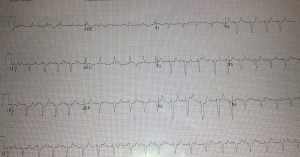50 yo F pmh ESRD, CHF presents with one day of “feeling bad.” HR 170s, received adenosine for suspected AVNRT and the rate “broke” into this ECG seen below:
Your only question… what could this rhythm be, and why?
Due to the inservice next week, you have until Thursday 2/26 at noon for comments and discussion. Best analysis wins the prize!
Many thanks to Joey Freedman, MD for this exciting case.
The views expressed on this blog are the author's own and do not reflect the views of their employer. Please read our full disclaimer here. Any references to clinical cases refer to patients treated at a virtual hospital, Janus General Hospital.
The following two tabs change content below.


eabram
Latest posts by eabram (see all)
- Rhythm Nation May 2015 Answer! - June 1, 2015
- Rhythm Nation May 2015 - May 10, 2015
- Rhythm Nation April 2015 – Answer! - April 20, 2015
- Rhythm Nation April 2015 - April 13, 2015
- Rhythm Nation March 2015 – Answer! - March 31, 2015


So, I don’t think I really have the whole answer, but I’ll go with what I got since I spent some time on it.
What could this rhythm be?
The rhythm appears to be some type of ventricular tachycardia given an irregular tachycardia at a rate of 110’s-130’s with most notably complete A-V dissociation with regular P waves, but no capture beats or fusion beats. The QRS is slightly widened at 100-120ms with left axis deviation and negative concordance in the precordial leads (all the precordial leads are negative). So, this rhythm appears to be a type of fascicular ventricular tachycardia. With no RBBB morphology, looks like the only option left is a upper septal fascicular block because it looks more like a LBBB than a RBBB.
Why?
Here’s where I’m a bit shaky (or was I shaky in that entire paragraph above? don’t really know). I remember reading somewhere that if you have an accessory pathway (like in WPW) and the person is in A fib/flutter and you give them AV-nodal blockers (like adenosine) that it can send people into VT, so that’s gonna be my guess: that there’s a fascular block with an accessory pathway and it was initially a re-entrant SVT which after blocking the AVN is now a VT but with a fascicular block. (although, if the person was really activating through the accessory pathway initially with afib/flutter, her rate should’ve been higher and it should have been a wide complex tachycardia which doesn’t look like AVNRT, soooo yeah)
Is the pre-adenosine ECG available? Maybe you can include it when you post the answer.